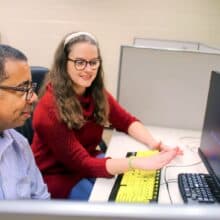Commentary: Making Classroom Technology Accessible for All
Last week, the federal government and Miami University in Ohio reached an agreement to provide access and equal opportunity to activities and classes for students with disabilities. The lawsuit – which came from a student who is blind – accused Miami University of failing to provide accommodations to students with disabilities and violating the Americans with Disabilities Act. Among other things, Miami University will make accessibility improvements in the technologies it currently uses, as well as meet with students with disabilities in order to develop a plan to make accommodations for each student.
Many people might wonder why there is still an accessibility problem in colleges and other facilities. After all, the ADA has been around for 26 years, so surely colleges and universities have all implemented changes to make buildings more accessible. This is accurate in the sense that many schools throughout the United States have installed ramps, elevators, Braille signs and wide entrances. Since the ADA was passed into law in 1990, it does not include accessibility standards for modern technology. Although independent organizations have developed standards to make websites more accessible, for example, few businesses or institutions adopt them, often because they are unaware they exist.
I know all too well about how inaccessible technology can present challenges to college students who are blind, because I myself experienced this situation in school. While my classmates could easily log on to computers in the library or computer lab, I would often show up just to find out that screen-reading technology was nonexistent on those machines. In other words, even finding an accessible computer can be difficult, often impossible, for students with disabilities. I was lucky to have my own accessible laptop, but there were still times when I desperately needed to do school work on another computer. The time when my laptop crashed right before finals is the first instance that comes to mind!
In today’s day and age, assistive technology helps people with disabilities be more independent and successful. Thanks to it, we can go to school, have jobs and be involved in social activities. Screen-reading and magnifying technology allows those of us with vision loss to use computers, smartphones and tablets just like everyone else. Technology is becoming more and more important in today’s world, and that is why schools should always consider the accessibility needs of its students with disabilities. Like anyone else, they want and deserve a positive experience while pursuing their education.
I hope that this agreement between Miami University and the federal government will help create more awareness for other schools regarding the accessibility of their classes and other activities. This will in turn create a more inclusive and welcoming environment for all students.

Sandy Murillo works at The Chicago Lighthouse, an organization serving the blind and visually impaired. She is the author of Sandy’s View, a bi-weekly Lighthouse blog about blindness and low vision. The blog covers topics of interest to those living with blindness and vision impairments. Being a blind journalist and blogger herself, Sandy shares her unique perspective about ways to live and cope with vision loss.





